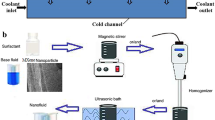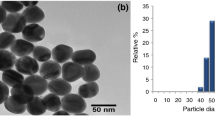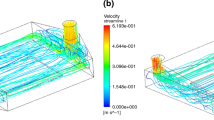Abstract
A huge number of chimneys all over the world utilized in many industrial applications and applications like restaurants, homes, etc. contribute badly on the global warming and climate change due to their waste heat. So, in this paper, the performance of thermoelectric generator (TEG) cooled by microchannel heat spreader having nanofluid and used for waste heat recovery from vertical chimney is investigated. Using heat spreader with microchannel cooling system increases the output TEG power compared to natural convection cooling system. In this paper, the impact of microchannel sizes, using nanofluid and heat spreader with different sizes on the TEG performance and cooling, is considered. Three-dimensional mathematical models including TEG, microchannel, nanofluid, and heat spreader are presented and solved by Ansys Fluent software utilizing user-defined memory, user-defined function, and user-defined scalar. All TEG effects (Joule, Seebeck, and Thomson) are considered in TEG model. Results indicate that TEG power rises with increasing the heat spreader and microchannel sizes together. Increasing microchannel and heat spreader sizes four times of TEG size raises the TEG output power by 10%. This also achieves the maximum cooling system efficiency of 88.9% and the maximum net output power. Microchannel heat spreader cooling system raises the system (TEG power-pumping power) net power by 125.2% compared to the normal channel and decreases the required cooling fluid flow rate. Utilizing copper–water and Al2O3-water nanofluids rises maximally the TEG output power by 14% and 4%, respectively; however, it increases the pumping power. Moreover, using nanofluids increases the net output power at low Reynolds number and decreases it at higher Reynolds number.









Similar content being viewed by others
Data availability
All data generated or analyzed during this study are included only in this paper and are not available in any other works.
Abbreviations
- \({c}_{p}\) (J/kg K):
-
Specific heat
- d (m):
-
Diameter
- h x (W/m2 K):
-
Local heat transfer coefficient
- \(\overrightarrow{j}\) (Amp/m2):
-
Current density vector
- \(k\)(W/m K):
-
Thermal conductivity coefficient
- M :
-
Molecular weight basic fluid, kg kmol
- N :
-
Normal direction
- n A :
-
Avogadro number
- P (W):
-
Power
- Pr:
-
Prandtl number
- \(\overrightarrow{q}\) (W/m2):
-
Heat flux vector
- Ra:
-
Rayleigh number
- Rex :
-
Local Reynolds number
- R l (Ω):
-
Load resistance
- \({S}_{e}\) (Amp/m3):
-
Electric potential model Source term
- \({S}_{h}\) (W/m3) :
-
Energy equation source term
- T (K):
-
Temperature
- T ∞ (K):
-
Ambient temperature
- T (s):
-
Time
- V (m/s):
-
Velocity
- x (m):
-
Location
- ATEG:
-
Thermoelectric generator surface area
- EP:
-
Electric potential model
- MC:
-
Microchannel
- HS:
-
Heat spreader
- TEG:
-
Thermoelectric generator
- UDF:
-
User-defined function
- UDM:
-
User-defined memory
- UDS:
-
User-defined scalar
- ZT:
-
Figure of merit
- \(\alpha\) (1/K):
-
Seebeck coefficient
- \(\sigma\) (Siemens/m):
-
Electric conductivity
- \(\rho\) (kg/m3):
-
Density
- \(\phi\) (V):
-
Electrical potential
- \(\varphi\) :
-
Volume fraction
- µ (Pa s):
-
Dynamic viscosity
- ν (m2/s):
-
Kinematic viscosity
- \(\beta\) (1/k):
-
Thermal expansion coefficient
- λ (m2/s):
-
Thermal diffusivity
- a:
-
Air
- c:
-
Cold
- f:
-
Fluid
- h:
-
Hot
- n:
-
N-type
- nf:
-
Nanofluid
- np:
-
Nanoparticle
- p:
-
P-type
- x,y,z :
-
Cartesian coordinates
- UDF:
-
User-defined function
References
Abdulmohsen AA (2016) Modeling and applications of thermoelectric generators. Ph.D thesis, Faculty of the Virginia Polytechnic Institute and State University
Albojamal A, Vafai K (2017) Analysis of single phase, discrete and mixture models, in predicting nanofluid transport. Int J Heat Mass Transf 114:225–237
Alfred OO, Tamer FM, Shinichi O, Hassan H (2022) Comprehensive review in waste heat recovery in different thermal energy-consuming processes using thermoelectric generators for electrical power generation. Processes. https://doi.org/10.1016/j.psep.2022.03.070
Aranguren P, Araiz M, Astrain D, Martínez A (2017) Thermoelectric generators for waste heat harvesting: a computational and experimental approach. Energy Convers Manag 148:680–691. https://doi.org/10.1016/j.enconman.2017.06.040
Asaadi S, Khalilarya S, Jafarmadar S (2018) Numerical study on the thermal and electrical performance of an annular thermoelectric generator under pulsed heat power with different types of input functions. Energy Convers Manag 167:102–112. https://doi.org/10.1016/j.enconman.2018.04.085
Bin Z (2014) A model study for cyclic thermal loading and thermal performance of a thermoelectric generator. Int J Energy Res 38:1351–1360. https://doi.org/10.1002/er.3152
Brauer J (2017) Thermoelectrics: design and materials. John Wiley & Sons Ltd, West Sussex
Champier D (2017) Thermoelectric generators: a review of applications. Energy Convers Manag 140:167–181. https://doi.org/10.1016/J.ENCONMAN.2017.02.070
Datta U, Dessouky S, Papagiannakis AT (2017) Harvesting thermoelectric energy from asphalt pavements. Transp Res Rec J Transp Res Board 2628:12–22. https://doi.org/10.3141/2628-02
Demir ME, Dincer I (2017) Performance assessment of a thermoelectric generator applied to exhaust waste heat recovery. Appl Therm Eng 120:694–707. https://doi.org/10.1016/J.APPLTHERMALENG.2017.03.052
El-Gazar EF, Zahra WK, Hassan H, Rabia SI (2021) Fractional modeling for enhancing the thermal performance of conventional solar still using hybrid nanofluid: Energy and exergy analysis. Desalination 503:114847. https://doi.org/10.1016/j.desal.2020.114847
Eldesoukey A, Hassan H (2019) 3D model of thermoelectric generator (TEG) case study: effect of flow regime on the TEG performance. Energy Convers Manag 180:231–239. https://doi.org/10.1016/j.enconman.2018.10.104
Falcão Carneiro J, Gomes de Almeida F (2018) Model and simulation of the energy retrieved by thermoelectric generators in an underwater glider. Energy Convers Manag 163:38–49. https://doi.org/10.1016/j.enconman.2018.02.031
Fernández-Yañez P, Armas O, Capetillo A, Martínez-Martínez S (2018) Thermal analysis of a thermoelectric generator for light-duty diesel engines. Appl Energy 226:690–702. https://doi.org/10.1016/j.apenergy.2018.05.114
Hassan H (2014) Heat transfer of Cu-water nanofluid in an enclosure with a heat sink and discrete heat source. Eur J Mech B Fluids 45:72–83. https://doi.org/10.1016/j.euromechflu.2013.12.003
Hassan H, Harmand S (2013a) A three-dimensional study of electronic component cooling using a flat heat pipe. Heat Transf Eng 34:596–607. https://doi.org/10.1080/01457632.2013.730426
Hassan H, Harmand S (2013b) 3D transient model of vapour chamber: effect of nanofluids on its performance. Appl Therm Eng 51:1191–1201. https://doi.org/10.1016/j.applthermaleng.2012.10.047
Hassan H, Harmand S (2015) Effect of using nanofluids on the performance of rotating heat pipe. Appl Math Model 39:4445–4462. https://doi.org/10.1016/j.apm.2014.12.023
Hassan H, Shafey NYA (2021) 3D study of convection-radiation heat transfer of electronic chip inside enclosure cooled by heat sink. Int J Therm Sci 159:106585. https://doi.org/10.1016/j.ijthermalsci.2020.106585
Hassan MA, Samanta R (2021) Heat exchanger assisted exhaust heat recovery with thermoelectric generator in heavy vehicles. Energy Technol 9:1–11. https://doi.org/10.1002/ente.202100037
Hilmin MNHM, Remeli MF, Singh B, Affandi NDN (2020) Thermoelectric power generations from vehicle exhaust gas with TiO2 nanofluid cooling. Therm Sci Eng Prog 18:. https://doi.org/10.1016/j.tsep.2020.100558
Hsiao YY, Chang WC, Chen SL (2010) A mathematic model of thermoelectric module with applications on waste heat recovery from automobile engine. Energy 35:1447–1454. https://doi.org/10.1016/j.energy.2009.11.030
Incropera FP, Dewitt DP, Bergman TL, Lavine AS (2011) Fundamentals of heat and mass transfer. Wiley
Jang JY, Tsai YC, Wu CW (2013) A study of 3-D numerical simulation and comparison with experimental results on turbulent flow of venting flue gas using thermoelectric generator modules and plate fin heat sink. Energy 53:270–281. https://doi.org/10.1016/j.energy.2013.03.010
Khalil H, Hassan H (2019a) Enhancement thermoelectric generators output power from heat recovery of chimneys by using flaps. J Power Sources 443:227266. https://doi.org/10.1016/j.jpowsour.2019.227266
Khalil H, Hassan H (2019b) 3D study of the impact of aspect ratio and tilt angle on the thermoelectric generator power for waste heat recovery from a chimney. J Power Sources 418:98–111. https://doi.org/10.1016/j.jpowsour.2019.02.020
Khalil H, Hassan H (2020) Enhancement of waste heat recovery from vertical chimney via thermoelectric generators by heat spreader. Process Saf Environ Prot 140:314–329. https://doi.org/10.1016/j.psep.2020.05.023
Khalil H, Saito T, Hassan H (2021) Comparative study of heat pipes and liquid-cooling systems with thermoelectric generators for heat recovery from chimneys. Int J Energy Res 1–12. https://doi.org/10.1002/er.7326
Kim CN (2018) Development of a numerical method for the performance analysis of thermoelectric generators with thermal and electric contact resistance. Appl Therm Eng 130:408–417. https://doi.org/10.1016/j.applthermaleng.2017.10.158
Kim TY, Negash A, Cho G (2017) Experimental and numerical study of waste heat recovery characteristics of direct contact thermoelectric generator. Energy Convers Manag 140:273–280. https://doi.org/10.1016/j.enconman.2017.03.014
Kumar S, Prasad SK, Banerjee J (2010) Analysis of flow and thermal field in nanofluid using a single phase. Appl Math Model 573–592
Lan S, Yang Z, Chen R, Stobart R (2018) A dynamic model for thermoelectric generator applied to vehicle waste heat recovery. Appl Energy 210:327–338. https://doi.org/10.1016/j.apenergy.2017.11.004
Lange RG, Carroll WP (2008) Review of recent advances of radioisotope power systems. Energy Convers Manag 49:393–401. https://doi.org/10.1016/J.ENCONMAN.2007.10.028
Lee H (2016) Thermoelectrics: design and materials. Wiley
Lee H, Sharp J, Stokes D et al (2018) Modeling and analysis of the effect of thermal losses on thermoelectric generator performance using effective properties. Appl Energy 211:987–996. https://doi.org/10.1016/j.apenergy.2017.11.096
Li Y, Wang S, Zhao Y, Yue L (2022) Experimental study on the effect of core flow heat transfer enhancement on the performance of TEG. Energy Rep 8:575–580. https://doi.org/10.1016/j.egyr.2021.11.218
Liao M, He Z, Jiang C, Fan X, Li Y, Qi F (2018) A three-dimensional model for thermoelectric generator and the influence of Peltier effect on the performance and heat transfer. Appl Therm Eng 133(493):500
Lu X, Yu X, Qu Z et al (2017) Experimental investigation on thermoelectric generator with non-uniform hot-side heat exchanger for waste heat recovery. Energy Convers Manag 150:403–414. https://doi.org/10.1016/j.enconman.2017.08.030
Lv S, He W, Jiang Q et al (2018) Study of different heat exchange technologies influence on the performance of thermoelectric generators. Energy Convers Manag 156:167–177. https://doi.org/10.1016/j.enconman.2017.11.011
Manca O, Nardini S, Ricci D, et al (2014) A numerical analysis on nanofluid mixed convection in triangular cross-sectioned ducts heated by a uniform heat flux. Adv Mech Eng 7:. https://doi.org/10.1155/2014/292973
Meng JH, Wang XD, Chen WH (2016) Performance investigation and design optimization of a thermoelectric generator applied in automobile exhaust waste heat recovery. Energy Convers Manag 120:71–80. https://doi.org/10.1016/j.enconman.2016.04.080
Ming T, Yang W, Huang X et al (2017) Analytical and numerical investigation on a new compact thermoelectric generator. Energy Convers Manag 132:261–271. https://doi.org/10.1016/j.enconman.2016.11.043
Mohammadnia A, Ziapour BM, Sedaghati F et al (2021) Fan operating condition effect on performance of self-cooling thermoelectric generator system. Energy 224:120177. https://doi.org/10.1016/j.energy.2021.120177
Prajwal KT, Bhat P (2021) Thermal analysis of a thermoelectric generator (TEG) using FEM technique. IOP Conf Ser Mater Sci Eng 1045:012018. https://doi.org/10.1088/1757-899x/1045/1/012018
Rezania A, Yazawa K, Rosendahl LA, Shakouri A (2013) Co-optimized design of microchannel heat exchangers and thermoelectric generators. Int J Therm Sci 72:73–81. https://doi.org/10.1016/j.ijthermalsci.2013.05.002
Sahin AZ, Yilbas BS (2009) The influence of operating and device parameters on the maximum efficiency and the maximum output power of thermoelectric generator. Int J Energy Res 31:135–147. https://doi.org/10.1002/er.1783
Said MA, Hassan H (2018a) Parametric study on the effect of using cold thermal storage energy of phase change material on the performance of air-conditioning unit. Appl Energy 230:1380–1402. https://doi.org/10.1016/j.apenergy.2018.09.048
Said MA, Hassan H (2018b) Effect of using nanoparticles on the performance of thermal energy storage of phase change material coupled with air-conditioning unit. Energy Convers Manag 171:903–916. https://doi.org/10.1016/j.enconman.2018.06.051
Sajid M, Hassan I, Rahman A (2017) An overview of cooling of thermoelectric devices. Renew Sustain Energy Rev 78:15–22. https://doi.org/10.1016/j.rser.2017.04.098
Selimefendigil F, Öztop HF (2021) Performance of TEG integrated channel with area expansion by using advanced passive techniques. Int J Mech Sci 194:106210. https://doi.org/10.1016/j.ijmecsci.2020.106210
Seo YM, Ha MY, Park SH et al (2018) A numerical study on the performance of the thermoelectric module with different heat sink shapes. Appl Therm Eng 128:1082–1094. https://doi.org/10.1016/j.applthermaleng.2017.09.097
Siddiqui MU, Arif AFM (2013) Electrical, thermal and structural performance of a cooled PV module: transient analysis using a multiphysics model. Appl Energy 112:300–312. https://doi.org/10.1016/j.apenergy.2013.06.030
Soliman AMA, Hassan H (2019) Effect of heat spreader size, microchannel con figuration and nanoparticles on the performance of PV-heat spreader-microchannels system. Sol Energy 182:286–297. https://doi.org/10.1016/j.solener.2019.02.059
Soliman AMA, Hassan H, Ahmed M, Ookawara S (2018) A 3d model of the effect of using heat spreader on the performance of photovoltaic panel (PV). Math Comput Simul. https://doi.org/10.1016/j.matcom.2018.05.011
Suhas Patankar (1980) Numerical heat transfer and fluid flow. Taylor & Francis
Torrecilla MC, Montecucco A, Siviter J et al (2018) Transient response of a thermoelectric generator to load steps under constant heat flux. Appl Energy 212:293–303. https://doi.org/10.1016/j.apenergy.2017.12.010
USA Alshehhi AA (2011) Sources and potential application of waste heat utilization at a gas processing facility. MSc. thesis, The Petroleum Institute (PI), Abu Dhabi, United Arab Emirates
von Lukowicz M, Abbe E, Schmiel T et al (2016) Thermoelectric generators on satellites—an approach for waste heat recovery in space. Energies 9:541. https://doi.org/10.3390/en9070541
Wang H, Jasim A, Chen X (2018) Energy harvesting technologies in roadway and bridge for different applications – a comprehensive review. Appl Energy 212:1083–1094. https://doi.org/10.1016/j.apenergy.2017.12.125
Wang P, Wang KF, Wang BL, Cui YJ (2019) Modeling of thermoelectric generators with effects of side surface heat convection and temperature dependence of material properties. Int J Heat Mass Transf 133:1145–1153. https://doi.org/10.1016/j.ijheatmasstransfer.2019.01.006
Yang W, Xie H, Sun L et al (2021) An experimental investigation on the performance of TEGs with a compact heat exchanger design towards low-grade thermal energy recovery. Appl Therm Eng 194:117119. https://doi.org/10.1016/j.applthermaleng.2021.117119
Zheng LJ, Kang HW (2021) A passive evaporative cooling heat sink method for enhancing low-grade waste heat recovery capacity of thermoelectric generators. Energy Convers Manag 251:114931. https://doi.org/10.1016/j.enconman.2021.114931
Zhou M, He Y, Chen Y (2014) A heat transfer numerical model for thermoelectric generator with cylindrical shell and straight fins under steady-state conditions. Appl Therm Eng 68:80–91. https://doi.org/10.1016/j.applthermaleng.2014.04.018
Acknowledgements
The authors would like to acknowledge the Mission Department of the Ministry of Higher Education (MOHE) of Egypt for providing a scholarship to conduct this study as well as Japan International Cooperation Agency (JICA) for offering some of the facilities, tools, and equipment required to carry out this research work.
Author information
Authors and Affiliations
Contributions
Ayman Eldesoukey: carried out theoretical calculations, plotted the results of data
Hamdy Hassan: writing the draft paper, analysis results, preparing data, revising the manuscript
Corresponding author
Ethics declarations
Ethics approval and consent to participate
All procedures performed in this study were in accordance with the ethical standards of the institutional and/or national research and ethical standards.
Consent for publication
The authors grant the publisher the sole and exclusive license of the full copyright in the contribution.
Competing interests
We disclose any actual or potential conflict of interest including any financial, personal, or other relationships with other people or organizations within 3 years of beginning the submitted work that could inappropriately influence, or be perceived to influence, this work.
Additional information
Responsible Editor: Philippe Garrigues
Publisher's note
Springer Nature remains neutral with regard to jurisdictional claims in published maps and institutional affiliations.
Rights and permissions
About this article
Cite this article
Eldesoukey, A., Hassan, H. Study of the performance of thermoelectric generator for waste heat recovery from chimney: impact of nanofluid-microchannel cooling system. Environ Sci Pollut Res 29, 74242–74263 (2022). https://doi.org/10.1007/s11356-022-21015-1
Received:
Accepted:
Published:
Issue Date:
DOI: https://doi.org/10.1007/s11356-022-21015-1




